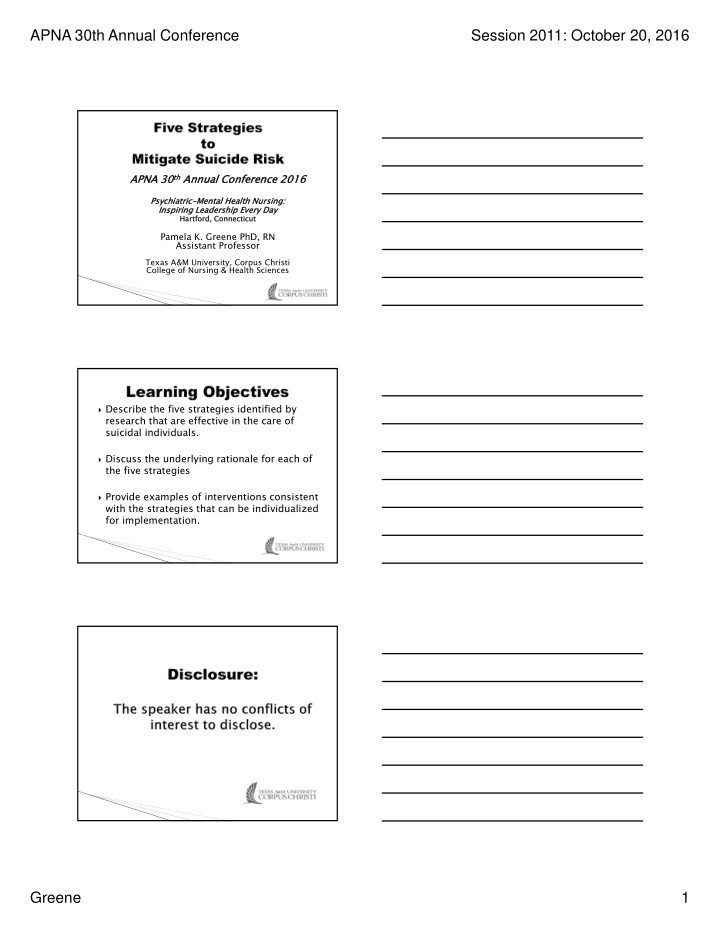



APNA 30th Annual Conference Session 2011: October 20, 2016 th Annu AP APNA NA 30 30 th Annual al Con Conference ce 2016 2016 Psychi ychiatri atric-Mental c-Mental H Heal alth N th Nursing: g: Inspir spiring ing Le Leader adershi ship Eve Every D y Day Hart rtford, rd, C Connectic cticut ut Pamela K. Greene PhD, RN Assistant Professor Texas A&M University, Corpus Christi College of Nursing & Health Sciences Describe the five strategies identified by research that are effective in the care of suicidal individuals. Discuss the underlying rationale for each of the five strategies Provide examples of interventions consistent with the strategies that can be individualized for implementation. Greene 1
APNA 30th Annual Conference Session 2011: October 20, 2016 Difficult to design interventions for complex phenomena with underlying processes that are not yet completely understood. Need increased methodological rigor ◦ Systematic review processes ◦ Methodological problems ◦ Paucity of demographic information and questionable ability to generalize to minority groups and other specialized populations ◦ Settings primarily outpatient ◦ Lack of study replication ◦ Outcomes not well defined ◦ Many without detailed psychotherapy manuals ◦ Longitudinal studies - attrition Brown, G., K. & Green, K. (2014) Brown, G.K. & Jager-Hyman, S. (2014) Sherry Davis Molock – 2014 1. What treatment worked? 2. What do the treatments have in common that could help with understanding why the treatment worked. LIMITATIONS ◦ Follow-up period Rudd, M.D., Williams, B., Trotter, D. (2011). 1. Easy to understand treatment model 2. Focus on treatment compliance 3. Emphasis on skills building 4. (Patient) Taking personal responsibility 5. Easy access to treatment and crisis services Rudd, M.D., Williams, B., Trotter, D. (2011) Stanley, C. 2013 Greene 2
APNA 30th Annual Conference Session 2011: October 20, 2016 Thoughts (includes core beliefs) Feelings (physiological & emotional) Behaviors (focus on adaptive) Slowed cognition, shame, and poor problem solving Avoidance ◦ Cognitive Lin Link to to Dev Development ◦ Behavioral ◦ Emotional Passive-aggressive behavior Submissive behavior Aggression Barriers Use specific interventions/techniques that target increasing motivation and collaboration ( Allen, 2011; Jobes, 2006). Clarity about what to do if “non-adherence” becomes an issue. Greene 3
APNA 30th Annual Conference Session 2011: October 20, 2016 Identify skills deficits with the opportunity to build and practice ◦ Emotiona ional R l Regulatio gulation ◦ Inte Interpersonal Clarification of “what is wrong” and “what to do about it” Relaxation Mindfulness Reasons for Living – list Survival kit ( includes reason for living ) Sleep hygiene Recognize the role of shame/guilt/grief Effective treatment emphasizes: Self-awareness Self-control Self-reliance Commitment to treatment Crisis management/safety plan Greene 4
APNA 30th Annual Conference Session 2011: October 20, 2016 Define a commitment to: ◦ Living ◦ Treatment & care Incorporates a crisis management or response plan Specifically identify responsibilities: ◦ Patient/client ◦ Clinician 1 . Triggers/Warning signs 2. Personal Coping Strategies: Calming or self- soothing or Distractions 3. External Support: Activities that Distract – social settings/personal contact 4. Professional Contacts with Phone Numbers 5. Where to go (and when) for emergency help 6. Steps to make environment safe (means restriction. 7. Reason for living Sarchiapone, Mandelli, Losue, Andrisano,& Roy, (2011) SAMHSA: National Suicide Prevention Lifeline www.suici.aspxdeprevntionlifeline.org/learn/safety Stanley & Brown (2008) C ounseling on A ccess to L ethal M eans Prog ogram ram D Descript ription 1.5 to 2 hour workshop designed to help providers implement counseling strategies to help clients at risk for suicide and their families reduce access to lethal means, particularly, but not exclusively, firearms. (www.sprc.org) Greene 5
APNA 30th Annual Conference Session 2011: October 20, 2016 Clear plan of action for emergencies ◦ Safety plan (and recognize when to use it) Dedication of time to prac practic ticing skills necessary to identify true crisis, using safety plan, and using external support services When I find myself making plans to suicide, I agree to: 1. Use my survival kit…. 2. Do things that help me feel better for about 30 minutes, including listening to music, coloring and going for a walk 3. Call the emergency number XXX-XXXX if the thoughts continue to get specific and I find myself preparing to act on the thoughts. 4. Go to the emergency room If I still feel suicidal and find myself unable to control my behavior. Modify for the treatment setting Include items that generate productive, hopeful thoughts & feelings Review items individually Practice the use of the Survival Kit ◦ Ask the patient/client to describe ◦ What are they thinking? ◦ What are they feeling? Schrank,B., Bird,V., Rudnick,A. & Slade, (2012) Greene 6
APNA 30th Annual Conference Session 2011: October 20, 2016 Flexibility By making: ◦ the implicit explicit ◦ the complex simple ◦ the confusing understandable ◦ the inaccessible available Allen, J. (2013) National Action Alliance for Suicide Prevention: Suicide Attempt Survivors Task Force. (2014) Greene 7
Recommend
More recommend